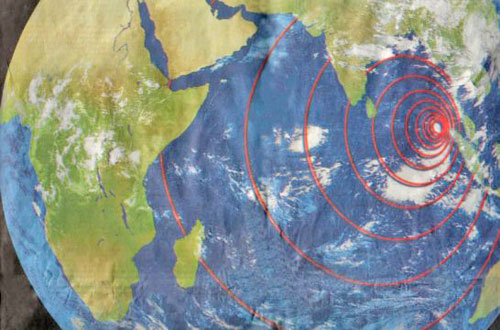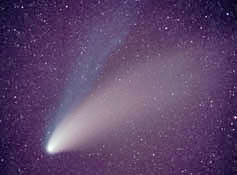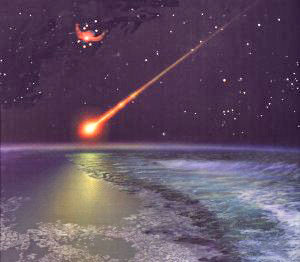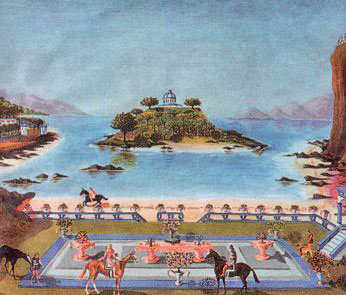|

by
Andy Lloyd
December 2004
Mankind has an amazing propensity for
self-inflicted wounds, but our appetite for destruction sometimes
pales into insignificance when placed against the kind of disasters
unleashed by Nature. My heart goes out to those caught up by that
wall of watery death unleashed by an 8.9 earthquake on Boxing Day,
2004, in the Indian Ocean. The death toll is truly staggering, the
suffering of the survivors hard to imagine.

Yet the cause of this tragedy is also a
reminder of the fragility of our life on this planet, and how close
we may all be to potential disaster. For decades Catastrophists have
argued the case for there having been repeated devastation of our
world in pre-historical times. That our emergence from caves to
civilization may not have been the smooth and relatively recent
transition alluded to in the history textbooks. Many have wondered
whether our progress has been less graduated, more stop/start; that
our human predecessors may have repeatedly fallen foul of natural
disasters that have affected our planet and environment.
This latest disaster affected coastal areas peripheral to the
epicenter of the sub-oceanic earthquake. A collapse of the sea bed
caused a ripple effect across the Indian Ocean that culminated in 30
foot waves in shallow waters; these waves then crashed into islands
and coastal areas causing devastation. It seems difficult to imagine
a worse scenario. Yet, similar events in recorded history have seen
tsunamis substantially higher, culminating in the movement of
oceanic waters deeper into land areas.
It is a fact that human settlements have always preferred coastal
areas to inhabit. Such areas are richer in good soils and wildlife,
and generally enjoy less extreme climates than more inland,
continental lands. But the risk attached to a substantial fraction
of the human population living near coastal areas is that the sea
might one day unleash devastation commonly affecting them all.
 Many
have wondered; is it possible that a worldwide disaster might have
been caused by a global tsunami? It would have to be a very
substantial wave indeed, one that originated from a devastating
catastrophe in oceanic waters. Not only that, but the epicenter of
such an event would have to have been positioned in such a way that
the wave was able to access all oceans and seas without having its
momentum broken by a substantial landmasses. This could only have
taken place, then, if the epicenter was in the Southern Oceans in
the vicinity of Antarctica. Many
have wondered; is it possible that a worldwide disaster might have
been caused by a global tsunami? It would have to be a very
substantial wave indeed, one that originated from a devastating
catastrophe in oceanic waters. Not only that, but the epicenter of
such an event would have to have been positioned in such a way that
the wave was able to access all oceans and seas without having its
momentum broken by a substantial landmasses. This could only have
taken place, then, if the epicenter was in the Southern Oceans in
the vicinity of Antarctica.
And the most likely source of such an event would be an oceanic
comet strike.
The tragic events of this week underline the potential catastrophe
we all face. There are many, many Flood myths from around the globe.
The Biblical account of Noah is not just a story popular in the
Levant, but one whose telling spanned the ancient world. But
scholars seem unwilling to give any credence to the idea that a
world-wide catastrophe of this nature may actually have occurred in
pre-historical times, leading to the extinction of many species. Yet
it is such a common myth across disparate cultures that there is
surely some truth to it. Scholars counter that such an event could
not have occurred across the whole face of the planet without some
kind of evidence being left behind. Yet, it is the very nature of
sudden flooding that little trace of the devastation remains long
after the event. The damage is literally washed away, or left buried
in a chaotic state.
 The
period towards the end of the last Ice Age seems a particularly
likely time for a massive tsunami to have occurred. The human
population would have been living in a relatively small band of
habitable land around the globe, pressed in from the poles by the
glacial ice. They would have lived in low-lying areas, as peoples
have always done historically, particularly given the extreme cold
of continental weather during the Ice Age. If a comet struck the
ocean near to Antarctica, unleashing a huge turbulence in the
world’s oceans, then many, many low-lying land areas across the
globe would have been devastated by massive tsunamis. In fact, it
might even have been an extinction event for many species of large
mammals, and may have triggered the sudden 50-year melt. Evidence of
such a catastrophe exists, and is well documented by many authors. The
period towards the end of the last Ice Age seems a particularly
likely time for a massive tsunami to have occurred. The human
population would have been living in a relatively small band of
habitable land around the globe, pressed in from the poles by the
glacial ice. They would have lived in low-lying areas, as peoples
have always done historically, particularly given the extreme cold
of continental weather during the Ice Age. If a comet struck the
ocean near to Antarctica, unleashing a huge turbulence in the
world’s oceans, then many, many low-lying land areas across the
globe would have been devastated by massive tsunamis. In fact, it
might even have been an extinction event for many species of large
mammals, and may have triggered the sudden 50-year melt. Evidence of
such a catastrophe exists, and is well documented by many authors.
It would take a whole book to cover the extent of known anomalies
pointing in this direction, and many have been written.
Furthermore, it is a fact that some of these Flood myths describe
prior celestial appearances of unusual stars and the like. The
observation of seven stars is a feature of some, perhaps alluding to
a series of in-coming comets (similar to
Shoemaker-Levy 9, perhaps),
providing the inhabitants of the earth with a grim portent of the
destruction to come, and perhaps encouraging some to prepare...
The seven stars might also have been indicative of a more rare
phenomenon; the re-appearance of
Nibiru. The perihelion of
the Dark
Star might have brought with it a barrage of in-coming objects. But
one must be cautious in such a claim; if the earth was subject to a
regular beating in this way then one would expect the Moon’s surface
to be pock-marked by relatively young craters too. Yet its surface
depicts generally older scarring. Comet-strikes seem to be rare,
even if they might be caused by some external influence like Nibiru.
Sitchin argued that a
global tsunami might have been caused
by the Antarctic ice Sheet becoming unstable over time and toppling
into the Sea catastrophically. Perhaps there may be some truth to
this; maybe in the form of a chain reaction of Ice Pack break-up and
glacial collapse. But a comet strike seems to me to be more likely.
 Others
speculate about the so-called
Lost Continent of Atlantis. Could such
a catastrophe account for the destruction of a whole continent? It
seems unlikely given the lack of evidence of such a fallen land-mass
in the Atlantic ocean itself. But one can imagine how the myths
about Atlantis may have been derived from the same source as that of
the Flood; that a whole civilization might have been literally swept
away by a towering, relentless wall of water. Others
speculate about the so-called
Lost Continent of Atlantis. Could such
a catastrophe account for the destruction of a whole continent? It
seems unlikely given the lack of evidence of such a fallen land-mass
in the Atlantic ocean itself. But one can imagine how the myths
about Atlantis may have been derived from the same source as that of
the Flood; that a whole civilization might have been literally swept
away by a towering, relentless wall of water.
Either way, the destruction seen in South East Asia shows what can
happen when a large earthquake happens out at sea, and how fragile
coastal communities are when faced with the consequences. Our
species as a whole is not under extinction threat from such an event
because we are now spread out throughout the entire globe. But that
was not always the case.
If one imagines us more closely packed in clement, low-lying climes
during an Ice Age, and imagine a much greater catastrophe unleashed
by Nature, then the Earths’ population of humans was far more
vulnerable. The mountain-dwelling survivors would remember such an
event through oral traditions for many, many generations.
How long will our amnesia-prone modern civilization remember this
latest catastrophe, and learn from it, I wonder?
|

 Many
have wondered; is it possible that a worldwide disaster might have
been caused by a global tsunami? It would have to be a very
substantial wave indeed, one that originated from a devastating
catastrophe in oceanic waters. Not only that, but the epicenter of
such an event would have to have been positioned in such a way that
the wave was able to access all oceans and seas without having its
momentum broken by a substantial landmasses. This could only have
taken place, then, if the epicenter was in the Southern Oceans in
the vicinity of Antarctica.
Many
have wondered; is it possible that a worldwide disaster might have
been caused by a global tsunami? It would have to be a very
substantial wave indeed, one that originated from a devastating
catastrophe in oceanic waters. Not only that, but the epicenter of
such an event would have to have been positioned in such a way that
the wave was able to access all oceans and seas without having its
momentum broken by a substantial landmasses. This could only have
taken place, then, if the epicenter was in the Southern Oceans in
the vicinity of Antarctica.  The
period towards the end of the last Ice Age seems a particularly
likely time for a massive tsunami to have occurred. The human
population would have been living in a relatively small band of
habitable land around the globe, pressed in from the poles by the
glacial ice. They would have lived in low-lying areas, as peoples
have always done historically, particularly given the extreme cold
of continental weather during the Ice Age. If a comet struck the
ocean near to Antarctica, unleashing a huge turbulence in the
world’s oceans, then many, many low-lying land areas across the
globe would have been devastated by massive tsunamis. In fact, it
might even have been an extinction event for many species of large
mammals, and may have triggered the sudden 50-year melt. Evidence of
such a catastrophe exists, and is well documented by many authors.
The
period towards the end of the last Ice Age seems a particularly
likely time for a massive tsunami to have occurred. The human
population would have been living in a relatively small band of
habitable land around the globe, pressed in from the poles by the
glacial ice. They would have lived in low-lying areas, as peoples
have always done historically, particularly given the extreme cold
of continental weather during the Ice Age. If a comet struck the
ocean near to Antarctica, unleashing a huge turbulence in the
world’s oceans, then many, many low-lying land areas across the
globe would have been devastated by massive tsunamis. In fact, it
might even have been an extinction event for many species of large
mammals, and may have triggered the sudden 50-year melt. Evidence of
such a catastrophe exists, and is well documented by many authors.
 Others
speculate about the so-called
Others
speculate about the so-called